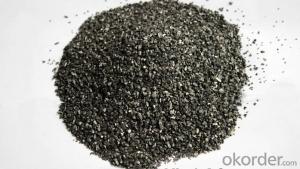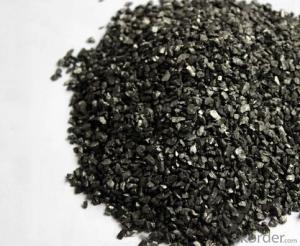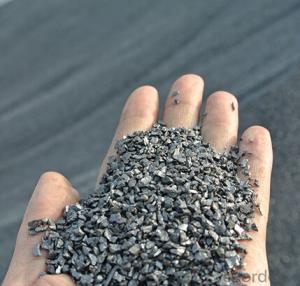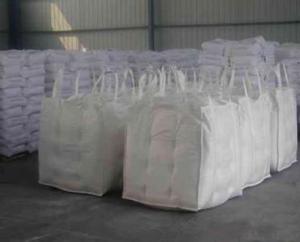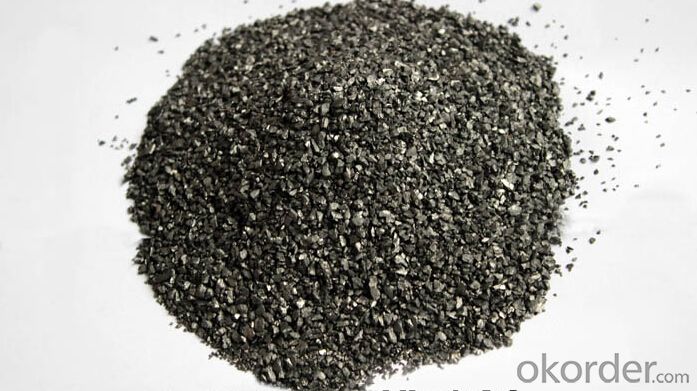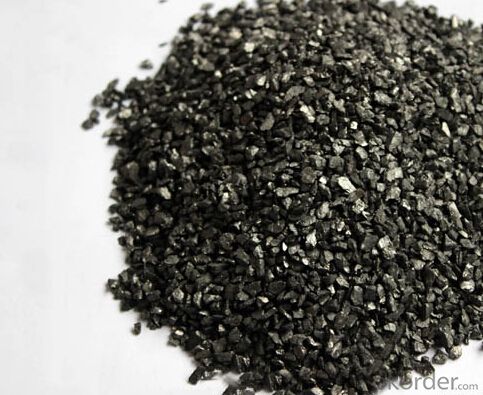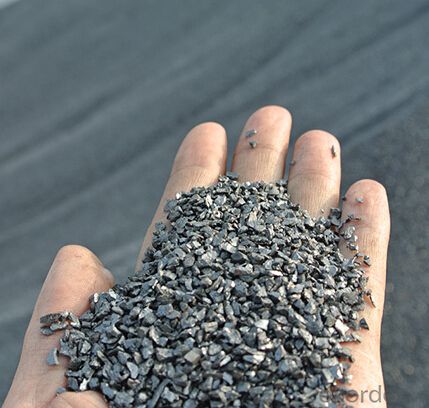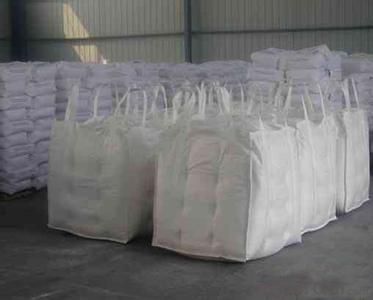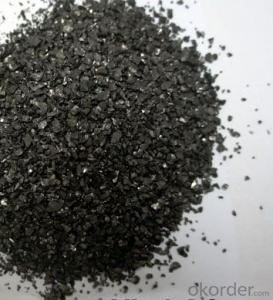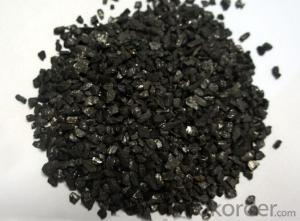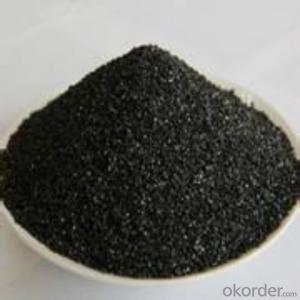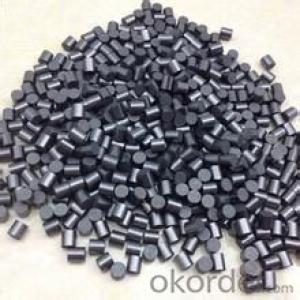Recarburizer 3-5MM 93% FC Carburant Carbon Additives for steel plant
- Loading Port:
- Qingdao
- Payment Terms:
- TT OR LC
- Min Order Qty:
- 10 m.t.
- Supply Capability:
- 50000 m.t./month
OKorder Service Pledge
OKorder Financial Service
You Might Also Like
Specifications Of Recarburizer 93% FC
- High C content;
- Low S and N content;
- High abosorbility;
Recarburizer(Carburant, carbon additives) with high quality, 0-20mm for metal casting foundry and steel plant, low nitrogen content and high carbon content, min 90% carbon content, at the same time as your requirements with no problem. The best media for adding carbon.
Technical Data Sheet of Recarburizer 93% FC
Fixed carbon | ≥ 93% |
Ash content | ≤ 5.0% |
Vol . Matter | ≤ 1.0% |
Sulphur content | ≤ 0.3% |
Moisture content | ≤ 0.3% |
Size | 0-20mm or as your requirement. |
Packing | - 25kg bag - One tone bags, Jumbo bag |
Delivery time | In 5-10 working days or depends on the order quantity |
Supply ability | 50000 Metric Ton Per Month |
Payment terms | L/C at sight or T/T |
Available Size: 0,1-4mm, 1-5mm, 3-8mm, 8-20mm (as per customers’ requirements)
Usage: widely used in casting foundry, steel-making, metallurgical Etc.
Applications of Recarburizer 93% FC
Mainly used in steel making in electrical stove, screening water, ship building sandblast to remove rust,producing carbon materials Etc.
Characteristics of Recarburizer 93% FC
- Particle size, porosity, absorption speed stable
- High degree of carbonize product, increase the original nuclear capability in the shape of liquid iron.
- Increased in the inoclation of nodular cast iron ball ink quantiyt, increase in th electric furnace iron graphit crystal nucleus.
- Excellent performance, stable.

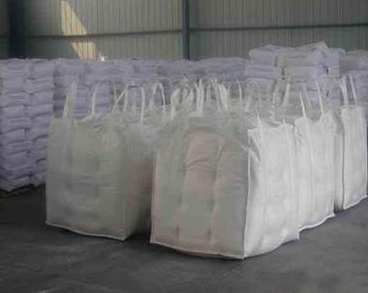
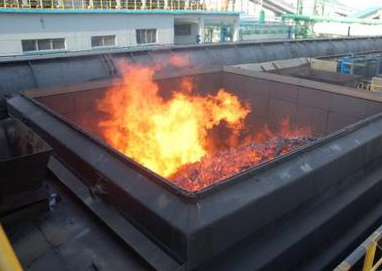
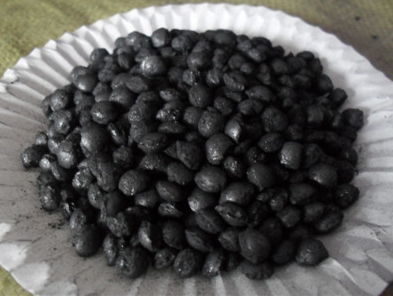
- Q: How is carbon formed?
- Various natural processes contribute to the formation of carbon, primarily the life and death cycle of living organisms. The process of photosynthesis in plants initiates carbon formation, as they utilize sunlight, water, and atmospheric carbon dioxide to produce glucose. This glucose is then transformed into other organic compounds, including carbohydrates, fats, and proteins, which are the fundamental constituents of all living beings. When plants and animals perish, decomposers like fungi and bacteria break down their remains and waste materials. During this decomposition, carbon is released back into the environment in the form of carbon dioxide or methane gas. Additionally, some organic matter may become buried beneath sediment layers, where it undergoes fossilization over millions of years. Through a combination of heat and pressure, this fossilization process converts the organic matter into fossil fuels like coal, oil, and natural gas, which are abundant sources of carbon. In addition to biological processes, carbon can also form through geological processes. Volcanic eruptions discharge carbon dioxide into the atmosphere, and over extended periods, this carbon dioxide can dissolve in water and react with minerals to create rocks like limestone. These rocks function as carbon sinks, storing substantial amounts of carbon over geological timescales. In general, the formation and cycling of carbon involve a complex interaction between biological and geological processes, significantly contributing to the equilibrium of carbon in the Earth's atmosphere and supporting life as we currently understand it.
- Q: What are greenhouse gases?
- Greenhouse gases are gases that trap heat in the Earth's atmosphere, contributing to the greenhouse effect and causing global warming. Some examples of greenhouse gases include carbon dioxide, methane, and nitrous oxide.
- Q: How does carbon affect the formation of smog?
- Carbon plays a significant role in the formation of smog, particularly in the form of carbon monoxide (CO) and volatile organic compounds (VOCs). When fossil fuels are burned, such as in vehicles, power plants, or industrial processes, carbon is released into the atmosphere in the form of CO and VOCs. These carbon emissions, especially in areas with high population density, can contribute to the formation of smog. Smog is a mixture of air pollutants, primarily ground-level ozone, which is formed when nitrogen oxides (NOx) and VOCs react in the presence of sunlight. Carbon monoxide is a precursor to the formation of ground-level ozone. It reacts with nitrogen oxides and sunlight to form ozone, a major component of smog. VOCs, on the other hand, react with nitrogen oxides in the presence of sunlight to form additional ground-level ozone. Additionally, carbon particles, also known as black carbon or soot, can contribute to the formation of smog. These particles absorb sunlight and heat the surrounding air, leading to temperature inversions. Temperature inversions trap pollutants close to the ground, preventing them from dispersing and exacerbating smog formation. Reducing carbon emissions is crucial in controlling and preventing smog formation. Implementing cleaner technologies, such as catalytic converters in vehicles and using cleaner fuels, can help decrease the release of carbon monoxide and VOCs. Furthermore, promoting renewable energy sources and reducing reliance on fossil fuels can significantly reduce carbon emissions, thus mitigating the formation of smog.
- Q: How is carbon used in the medical field?
- The medical field utilizes carbon in various ways, thanks to its unique properties. Activated charcoal, for example, is commonly used in hospitals to treat cases of poisoning or drug overdoses. Its large surface area allows it to adsorb toxins and chemicals, preventing their absorption into the bloodstream. Carbon also plays a role in medical imaging techniques like positron emission tomography (PET) scans. Carbon-11, a radioactive form of carbon, is used to label molecules such as glucose in PET scans. This labeled carbon is injected into the patient, and a PET scanner detects its distribution in the body. This technique aids in diagnosing and monitoring diseases, including cancer, by visualizing metabolic activity in organs and tissues. Additionally, carbon-based materials like carbon nanotubes and graphene are extensively researched for their potential in drug delivery systems. These materials can be modified to transport therapeutic agents, such as drugs or genes, to specific targets in the body. Carbon nanotubes, in particular, have shown promise in enhancing drug delivery efficiency and reducing side effects. Furthermore, carbon plays a vital role in manufacturing medical devices and implants. Carbon fiber-reinforced polymers are used in orthopedic implants and prosthetics due to their strength, flexibility, and biocompatibility. Carbon-based materials are also crucial in producing electrodes for medical devices like pacemakers, defibrillators, and neurostimulators. In conclusion, carbon has a wide range of applications in the medical field, from treating poisonings to improving diagnostic imaging techniques, drug delivery systems, and the production of medical devices. It continues to be a crucial component in advancing medical technology and enhancing patient care.
- Q: Last night to go to the supermarket to buy 5 batteries, see Toshiba carbon batteries, I finally bought the super alkaline batteries, alkaline batteries and carbon is the difference in where? What kind of battery is best for digital cameras? Thank you
- Alkaline battery discharge point, carbon battery's full name should be carbon zinc batteries (because it is the general level is the carbon rod electrode is the zinc skin), also known as zinc manganese battery, is currently the most common dry battery, it has the characteristics of low price and safe and reliable use, environmental factors based on the consideration.
- Q: What is the impact of carbon emissions on agriculture?
- Carbon emissions have a significant impact on agriculture, affecting both crop production and livestock farming. One of the primary consequences of increased carbon emissions is climate change, which alters weather patterns and temperatures. These changes can disrupt the delicate balance required for successful agriculture. Rising temperatures caused by carbon emissions lead to increased evaporation, which can reduce soil moisture and hinder crop growth. Droughts become more frequent and severe, leading to water scarcity and decreased crop yields. Furthermore, extreme weather events such as floods, storms, and hurricanes become more frequent, causing extensive damage to crops and farmland. Another consequence of carbon emissions is the alteration of atmospheric composition. High levels of carbon dioxide (CO2) stimulate the growth of certain weeds and invasive species, which compete with crops for resources such as sunlight, water, and nutrients. This competition can lead to reduced crop yields and lower quality produce. Additionally, carbon emissions contribute to air pollution, including ozone formation. High levels of ozone can damage plant tissues and reduce photosynthesis, limiting crop productivity. Ozone also negatively affects the health of livestock, reducing their growth rates and milk production. The impact of carbon emissions on agriculture is not limited to crop production. Livestock farming is also affected, as changes in climate and temperature can impact animal health and productivity. Heat stress becomes a significant issue, leading to reduced fertility, lower milk yields, and increased susceptibility to diseases. Livestock also need access to adequate water and nutritious feed, which can become scarce due to droughts and increased competition for resources. Overall, carbon emissions have a detrimental impact on agriculture, affecting both crop production and livestock farming. Climate change, altered weather patterns, and increased competition for resources all contribute to reduced yields, lower quality produce, and decreased livestock productivity. Addressing and mitigating carbon emissions is crucial to ensure the sustainability and resilience of the agricultural sector in the face of these challenges.
- Q: How can carbon capture and storage be implemented?
- CCS technology, which captures and stores carbon dioxide emissions from industrial processes, is crucial for preventing their release into the atmosphere. The implementation of CCS involves several key steps. First and foremost, CO2 emissions are captured from power plants, factories, and other industrial sources using different methods such as pre-combustion capture, post-combustion capture, and oxy-fuel combustion. Pre-combustion capture involves converting fossil fuels into a hydrogen and CO2 mixture, with the latter being separated and stored. Post-combustion capture removes CO2 from the flue gases after combustion. Oxy-fuel combustion, on the other hand, burns fossil fuels in pure oxygen, resulting in a flue gas that is predominantly CO2. After the capture process, the second step is transportation. The captured CO2 must be transported from the capture site to a storage site. This can be accomplished through pipelines, ships, or trucks, depending on the distance and volume of CO2. Pipelines are the most commonly used method, particularly for large-scale projects, due to their cost-effectiveness and efficiency. The third step involves storage, which entails injecting the captured CO2 deep underground into geological formations for long-term storage. The most suitable storage sites include depleted oil and gas fields, saline aquifers, and deep coal seams. These sites have the capacity to securely store significant amounts of CO2 for hundreds or even thousands of years. Monitoring and verification are crucial for ensuring the safety and effectiveness of CCS. Continuous monitoring is necessary to detect any potential leaks or seismic activities that could compromise the integrity of the storage site. Verification activities involve assessing the long-term storage of CO2 and ensuring compliance with regulations and standards. The successful implementation of CCS also requires policy support and financial incentives. Governments can provide regulatory frameworks, tax incentives, and funding to encourage the adoption of CCS technologies. International cooperation and collaboration are also vital, as CCS can be a global solution to mitigate climate change. In conclusion, the implementation of carbon capture and storage involves capturing, transporting, injecting, and monitoring CO2 emissions. It necessitates various technologies, infrastructure, and policy support for widespread adoption. By effectively implementing CCS, we can make significant reductions in greenhouse gas emissions and combat climate change.
- Q: Is the hardness or softness of the steel with higher carbon content?
- The increase of carbon content also reduces the weldability and corrosion resistance of steel, and increases the cold brittleness and aging tendency of steel.
- Q: How can carbon capture and storage help reduce greenhouse gas emissions?
- Carbon capture and storage (CCS) is a technology that can play a significant role in reducing greenhouse gas emissions. It involves capturing carbon dioxide (CO2) produced from industrial processes or power generation, transporting it, and then storing it underground in geological formations. Firstly, CCS can help reduce greenhouse gas emissions by capturing CO2 directly from large point sources, such as power plants or industrial facilities, that would otherwise be released into the atmosphere. By capturing and storing this CO2, it prevents it from contributing to the greenhouse effect and mitigates its impact on climate change. Secondly, CCS can enable the continued use of fossil fuels, such as coal or natural gas, in a more environmentally friendly manner. These fuels are currently the primary sources of energy for electricity generation and industrial processes. By implementing CCS, the CO2 emissions from these fossil fuel-based activities can be drastically reduced, allowing for a transition towards cleaner energy sources in a more gradual and economically feasible manner. Furthermore, CCS can also be coupled with bioenergy production, creating what is known as bioenergy with carbon capture and storage (BECCS). This process involves using biomass, such as crop residues or purpose-grown energy crops, to produce energy. The CO2 emitted during the bioenergy production is then captured and stored, resulting in a negative emissions process. BECCS can effectively remove CO2 from the atmosphere, helping to offset emissions from other sectors and achieving net-negative emissions. Lastly, CCS can contribute to the decarbonization of hard-to-abate sectors, such as cement and steel production, where alternative low-carbon technologies are currently limited. By capturing and storing CO2 emissions from these sectors, CCS can significantly reduce their overall greenhouse gas emissions and facilitate their transition towards more sustainable practices. In conclusion, carbon capture and storage technology can help reduce greenhouse gas emissions by directly capturing and storing CO2 from large point sources, allowing for the continued use of fossil fuels in a more sustainable manner, enabling the deployment of negative emissions technologies like BECCS, and supporting the decarbonization of hard-to-abate sectors. Implementing CCS alongside other mitigation strategies can play a vital role in achieving global climate goals and combating climate change.
- Q: I want to make a rectangular round bar for bearing. What carbon fiber and carbon fiber should be used? How should I do it? What kind of machine does it use to dry it?
- Not really. Carbon fiber is only a reinforcing material, similar to glass fiber, without cohesive force.In general, the carbon fiber cloth is to be made of pre impregnated fabric by wet or melting method, and then cut, then laid or rolled to form the embryo according to the shape to be made. Finally, the mold is heated and pressurized and shaped.Plastic molding may be referred to
Send your message to us
Recarburizer 3-5MM 93% FC Carburant Carbon Additives for steel plant
- Loading Port:
- Qingdao
- Payment Terms:
- TT OR LC
- Min Order Qty:
- 10 m.t.
- Supply Capability:
- 50000 m.t./month
OKorder Service Pledge
OKorder Financial Service
Similar products
Hot products
Hot Searches
